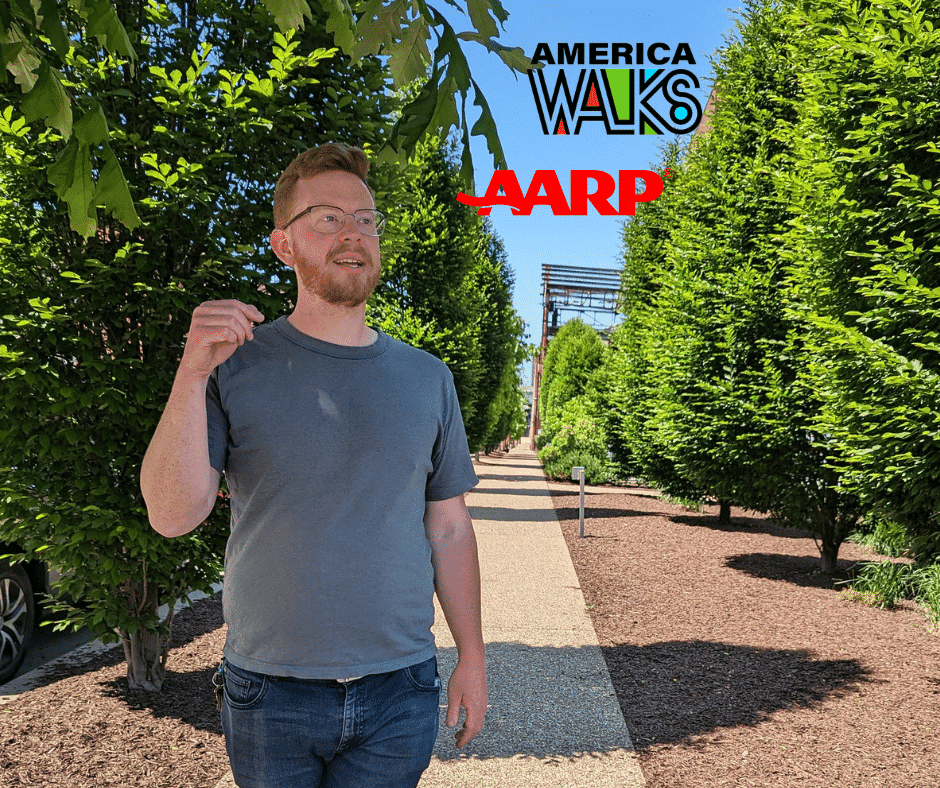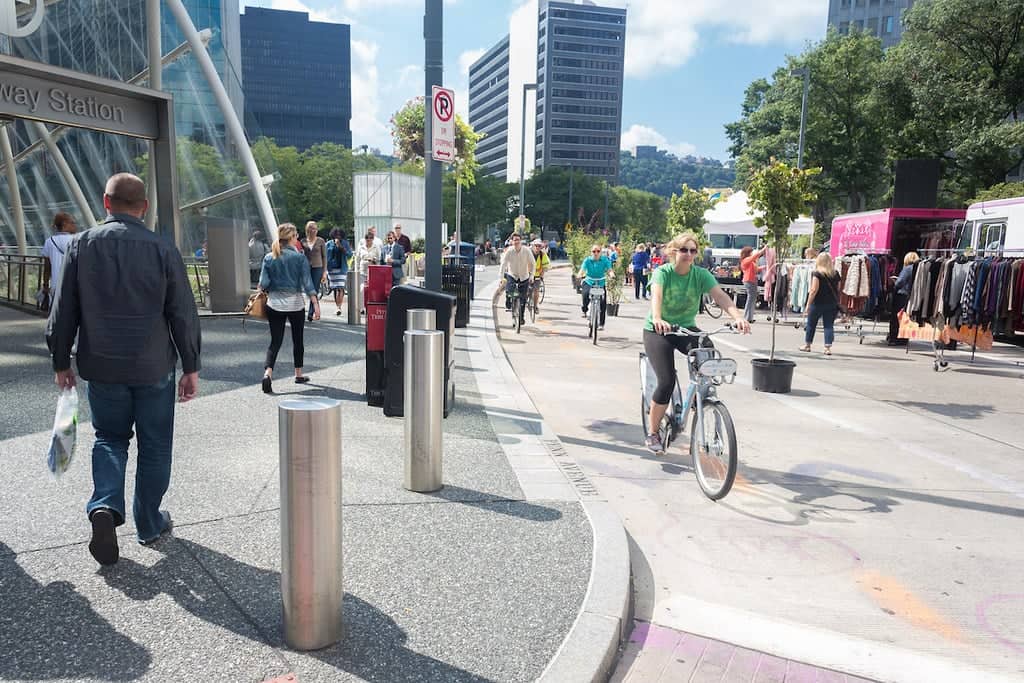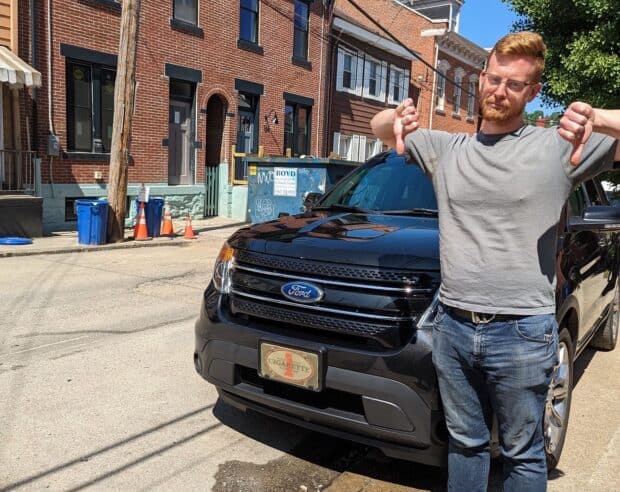
Gathering the tools to center pedestrians in our advocacy!
BikePGH is going to college! …well, our Advocacy Manager, Seth Bush, is currently enrolled in PA Walking College. That’s right, Seth was accepted into the 2023 Pennsylvania State Walking College Fellowship Program through America Walks and AARP. So what is PA Walking College and why’s it important, you ask? We had a conversation with Seth and asked him these questions, so you can hear directly about how he’s growing his skills as an advocate for people who walk.
We’ll be interviewing Seth on what he’s learned along the way, which will culminate in an on-the-ground project he’ll be leading. So, stay tuned for more in this blog series! For now, here’s the basics of what Seth’s learned in Month 1 at PA Walking College.
But first, why pedestrian advocacy?
Having access to clear sidewalks is absolutely essential to our communities and our quality of life. Some years ago, BikePGH added pedestrian advocacy into our mission in addition to cyclist advocacy. As Seth prioritizes this fellowship program, BikePGH can have yet another tool in our toolkit to help enact real change to better serve vulnerable road users in our community.
…Okay, now on to Seth’s interview!
Q: What is PA Walking College?
Seth: PA walking college is a state-specific version of the National Walking College through America Walks. This is the first year of the PA walking college.
The purpose is to learn how to be better advocates for pedestrian safety. There’s an epidemic of pedestrian deaths, and a harmful car culture that’s connected to the loss of walkability in our cities. The Walking College aims to remedy that by giving resources to people who are best positioned in their communities to make real change for walkability and accessibility.
There are 19 of us fellows, from elected officials to city planners, to local government, to advocates and organizers (like me!). Basically, anyone who is a leader in their community or looking to be a leader on the basis of serving pedestrians. We’re learning about policy, infrastructure, what’s feasible and what’s not. Ultimately, the purpose is to make an actionable plan in our communities.
“The goal of the Pennsylvania State Walking College is to build the capacity of local advocates to advance policy, systems, and environment change to create healthy, walkable communities throughout the state.
The 2023 Pennsylvania State Walking College Fellowship Program
This is accomplished through 6-month Fellowships which will provide training in best practices, a network of peers and mentors, and individual coaching in developing a community-specific Walking Action Plan.”

Q: Why is it significant that BikePGH’s Advocacy Department is doing this type of pedestrian advocacy work, and how do you plan to use what you learn?
Seth: For me in this role as Advocacy Manager at BikePGH, it’s really important to me that we have an emphasis on pedestrian advocacy. This course is a great opportunity to deepen our understanding of pedestrian issues. It really gets down to equity. There are a lot of ways people get around that don’t involve cars (about a quarter of all Pittsburgh households don’t have access to a car). This means they’re getting around in other ways. Even transit riders from point A to point B are walking some of the way. Over history, we’ve lost some really important features that help take care of people who walk and roll, and we need to find ways to recoup those losses.
There’s also a mutual benefit between making streets safer for walking and biking – though it’s important to acknowledge that sometimes biking isn’t the best way into making a street safer for everyone. Many times, focusing on walking is the best way to improve a street’s safety and accessibility.
I often ponder, what if it was the obvious thing to not own a car because our streets and communities were designed so well? What if walking and rolling was the easiest and most enjoyable way to get around, making it irresistible to not have a car…🤔💭

Q: I understand there are three themes per month where you delve into different topics. Can you give me an overview of the past month’s themes and why they’re important?
Seth: To start things off, we took a deep dive into history:
- Week 1: A History of Transportation
- Week 2: A History of Systemic Injustice
- Week 3: Learning From History
So, what are we learning from history? First, the car industry has shaped our city landscapes by making walking illegal in a lot of ways. Back in the day when we were walking more, the car industry began to use their power and lobby to make us car dependent, while at the same time putting crashes on the fault of the individual rather than the design of the system – i.e. jaywalking.
There has also been systemic injustice through highways and how cities were designed, which led to barring Black and Brown people from accessing generational wealth, leading to a legacy of disinvestment, health problems, and bad sidewalks in these communities.
A good example of the history of systemic injustice in transportation in Pittsburgh is the Eastern Busway. This busway, now, does a lot of good. When it was built, it was problematic, because the Eastern Busway was pumping diesel fumes into predominantly working class, Black and Brown communities and causing an environmental justice issue. Part of what came about from that was that Edgewood (a more white and wealthy neighborhood) was offered a stop on the busway with connecting sidewalks– but they said no– because they didn’t want Black and Brown people from surrounding communities to come into their neighborhood. There was a wrongful fear that if Black people came to the neighborhood it would lower property values. So now, they don’t have a busway. Fast forward – See how 376 is segregating these areas. The sidewalk literally ends here, and now these communities are missing out on the new generation of public transit users.

Furthermore, across the country we now have this system of disjointed amenities that require people to drive across town to access basic needs, which is also very connected to food sovereignty, generational health, and a lack of investment in public transit. For instance, low income, Black and Brown communities are the communities that end up having the worst sidewalks and biking infrastructure due to the long standing effects of a history of segregation and disinvestment.
So now, you might live within a mile of school, but your route to get there safely is either non-existent, or longer than you’re willing to walk/bike due to how the streets are designed. Thus, because bad design forces us to drive when we could otherwise walk, we’re also missing out on the physical and mental health benefits of walkability. We know that walking 30 minutes a day reduces the risk of heart disease and stroke by 35%, and walking benefits our mental health as well. While there are approximately 4,000 pedestrian deaths annually in the US, there are 100x that many deaths due to physical inactivity and poor nutrition. We could solve both of those problems of activity and nutrition by designing our communities to be walkable.
There are all these benefits to walking and all sorts of ways we’re missing out when life is centered on car culture. Something I’ve been thinking about is what we have lost and what we are missing out on as a culture and society by putting walking on the margins. Literally– on the margins– as sidewalks. Before cars, walking was not delegated to the side of the street. People were free to walk around. It stands to consider what we’re missing out on by designing our streets solely for on cars and getting around fast (also note that safety and speed are incompatible goals for street design). And now, we’re missing out on human connection! In fact, there’s an epidemic of loneliness in our country, as per the surgeon general’s report. When we’re not walking around, we’re not connecting with our neighbors.
“The auto industry wanting to make a buck shaped how our cities are designed… We are being stripped of our right to walk.” – Seth Bush
Q: Do you have any interesting resources to share with us so far?
Seth: Yes! The curriculum includes curated articles, reports, videos, and other resources that I get to review each week. Below are two resources that I highly recommend checking out, and you can click here to read my notes and reading journal.
Q: Is there anything else that BikePGH’s Advocacy department is working on related to pedestrian / sidewalk safety that you can share with our audience?
Seth: A cultural phenomenon we are seeing is parking on the sidewalks. It really comes down to design and accessibility. When vehicles park on the sidewalks, people on the sidewalks are forced to go into the street to get around. People who use mobility aids and wheelchairs have to constantly backtrack and dodge these vehicles that are clogging up these spaces that are intended for pedestrians. We all have a part to play, it comes down to our streets having too many cars on them (and in Pittsburgh, the streets can be quite narrow). It’s easy to want to place blame on the individual, but there’s also a design issue at play and a culture of car dependency. We can’t just brush it off and say that’s just the way it is. Parking on the sidewalk is hurting a lot of people every day.


That’s why BikePGH will soon be launching a new campaign to Raise awareness of this illegal and bad practice. We’ll highlight the consequences of parking on the sidewalk and encourage people to change their behaviors. Promoting responsible parking habits can create a safer and more accessible environment for everyone. Keep an eye out for this!
Alright, that’s it for now! Thank you, Seth, for sharing your knowledge with us as you continue your learning at PA Walking College this summer. Stay tuned next month as we learn more about this curriculum and how BikePGH’s Advocacy Department is planning to put it to use through our ongoing pedestrian advocacy and new campaign, launching soon.